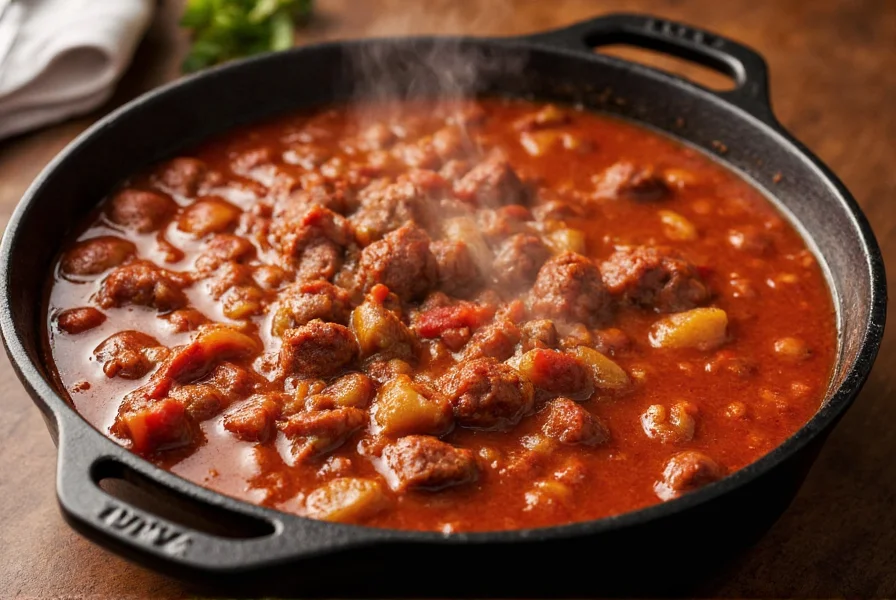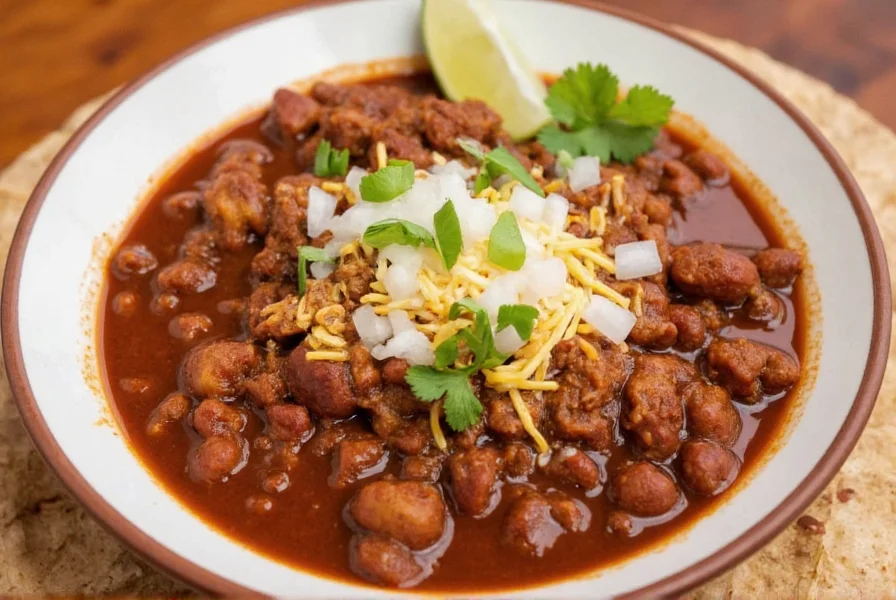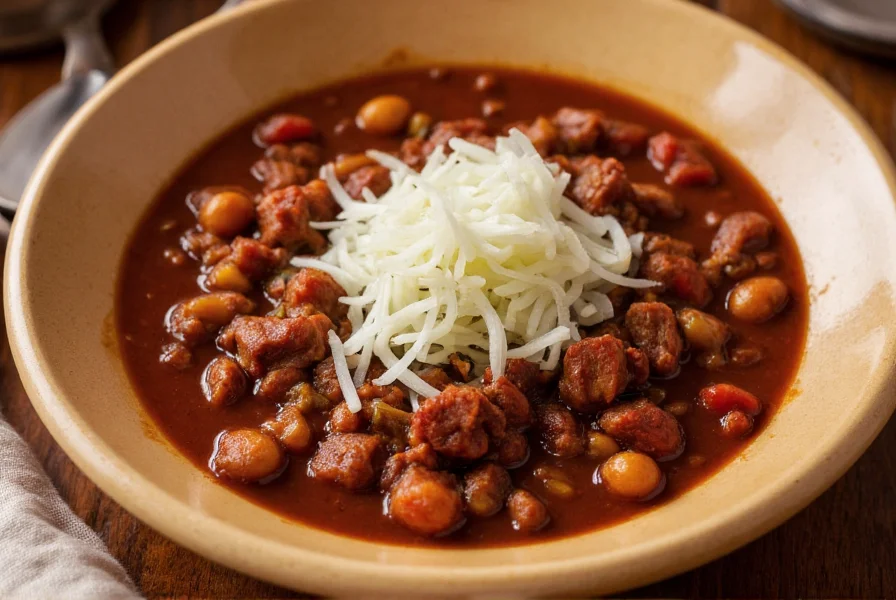Brisket chili stands apart from traditional ground beef or chuck roast chili with its distinctive texture and deep beef flavor. When prepared correctly, this dish offers a luxurious eating experience where the meat practically dissolves into the rich, complex broth. The magic happens through proper collagen breakdown during extended cooking, creating a naturally thickened, velvety texture that regular chili often lacks.
Why Brisket Elevates Your Chili Game
Brisket's unique composition makes it ideal for chili preparation. Unlike leaner cuts that dry out during prolonged cooking, brisket contains abundant connective tissue and marbling that transforms during slow cooking. As collagen breaks down into gelatin, it creates a luxurious mouthfeel while naturally thickening the chili without needing excessive starches or roux.
The flat cut (first cut) of brisket typically weighs 6-8 pounds and features consistent marbling with a manageable fat cap. This cut provides the perfect balance for chili—sufficient fat for flavor without overwhelming the dish with grease. Many home cooks mistakenly use the point cut, which contains too much intramuscular fat that can make chili greasy despite careful skimming.
Essential Components for Perfect Brisket Chili
Creating exceptional brisket chili requires attention to three critical elements: meat preparation, spice balance, and cooking methodology. Each component plays a vital role in developing the complex flavor profile that distinguishes great brisket chili from ordinary versions.
| Brisket Cut | Fat Content | Best For Chili? | Preparation Tip |
|---|---|---|---|
| Flat (First Cut) | Moderate marbling | ✓ Ideal | Trim fat cap to 1/4 inch |
| Point (Second Cut) | High marbling | ✗ Not recommended | Excess fat requires careful skimming |
| Packaged 'Chili Meat' | Variable | △ Acceptable | Check for connective tissue presence |
Step-by-Step Brisket Chili Preparation
Follow this professional approach to achieve restaurant-quality brisket chili at home. The process spans two days for optimal results, with proper resting time being as crucial as the cooking itself.
Day 1: Preparation and Initial Cooking
- Trim and cut: Remove excess fat from the brisket flat, leaving approximately 1/4 inch. Cut into 2-inch cubes, maintaining uniform size for even cooking.
- Dry brine: Season generously with kosher salt (1 tablespoon per pound) and refrigerate uncovered for 12 hours. This enhances flavor penetration and surface browning.
- Sear properly: Heat oil in a heavy pot to 375°F. Sear brisket in small batches without crowding, achieving deep mahogany color on all sides. This Maillard reaction creates foundational flavors.
- Build flavor base: After removing meat, sauté onions, garlic, and poblano peppers until caramelized. Add tomato paste and cook until brick red, about 5 minutes.
- Layer spices: Incorporate chili powder, cumin, and smoked paprika, toasting for 1 minute before deglazing with dark beer.
Day 2: Final Cooking and Finishing
- Low and slow: Return brisket to pot with broth (enough to cover by 1 inch). Maintain 200-210°F for 8-10 hours until meat shreds easily.
- Skim carefully: Every 2 hours, remove congealed fat from surface using a spoon. This prevents greasy texture without disturbing the developing gelatin.
- Final reduction: Remove meat, strain broth, and reduce by one-third to concentrate flavors before returning meat.
- Rest overnight: Refrigerate completely before serving. This allows flavors to meld and makes fat removal effortless.

Avoiding Common Brisket Chili Mistakes
Even experienced cooks encounter pitfalls when preparing brisket chili. Understanding these common errors ensures consistent success:
- Incorrect temperature: Cooking above 215°F causes muscle fibers to contract excessively, squeezing out moisture before collagen breaks down. Maintain 200-210°F for optimal results.
- Skipping the rest: Cutting or serving immediately after cooking prevents gelatin from setting. The overnight rest transforms texture from soupy to luxuriously thick.
- Over-seasoning early: Salt concentration increases as liquid reduces. Add final seasoning after reduction to avoid oversalting.
- Using pre-cut 'chili meat': Most supermarket options lack sufficient connective tissue. Choose whole brisket flat for authentic texture.
Serving and Storage Guidelines
Proper presentation enhances your brisket chili experience. The ideal serving temperature is 165-175°F—hot enough to maintain texture but not so hot that it masks subtle flavors. Traditional accompaniments include:
- Crumbled queso fresco or sharp cheddar
- Freshly chopped white onions
- Lime wedges for acidity balance
- Warm cornbread or flour tortillas
For storage, keep chili in airtight containers for up to 5 days in the refrigerator or freeze for 3 months. The flavor actually improves after 2-3 days as ingredients fully integrate. When reheating, add a splash of broth to restore ideal consistency.

Frequently Asked Questions
Can I make brisket chili in a slow cooker?
Yes, but with modifications. Set your slow cooker to 'low' (approximately 200°F) and cook for 10-12 hours. The critical factor is maintaining temperature below 210°F to properly break down collagen without drying the meat. Check after 8 hours to prevent overcooking.
Why is my brisket chili tough despite long cooking?
Tough brisket typically indicates insufficient cooking time or temperature too low to break down collagen. Brisket requires 8-10 hours at 200-210°F. If your chili remains tough, continue cooking in 30-minute increments until fork-tender. Ensure your cooking liquid maintains a gentle simmer throughout.
What's the difference between brisket chili and regular chili?
Brisket chili uses whole brisket cuts that transform during slow cooking, creating a naturally thickened broth from gelatin. Regular chili typically uses ground beef or chuck roast, resulting in different texture and less complex mouthfeel. Brisket chili has deeper beef flavor and luxurious texture due to collagen conversion.
How do I fix greasy brisket chili?
Chill the chili completely, then remove the solidified fat layer from the surface. For immediate correction, place ice cubes in a paper towel and swirl through hot chili—the fat will adhere to the cold surface. Prevent greasiness by using the flat cut of brisket and skimming fat every 2 hours during cooking.
Can I use smoked brisket for chili?
Yes, but adjust your approach. Smoked brisket has already undergone collagen breakdown, so add it during the final 2 hours of cooking to prevent disintegration. Reduce liquid by 25% since smoked meat releases less collagen. This creates a hybrid preparation combining smoked flavor with traditional chili spices.











 浙公网安备
33010002000092号
浙公网安备
33010002000092号 浙B2-20120091-4
浙B2-20120091-4